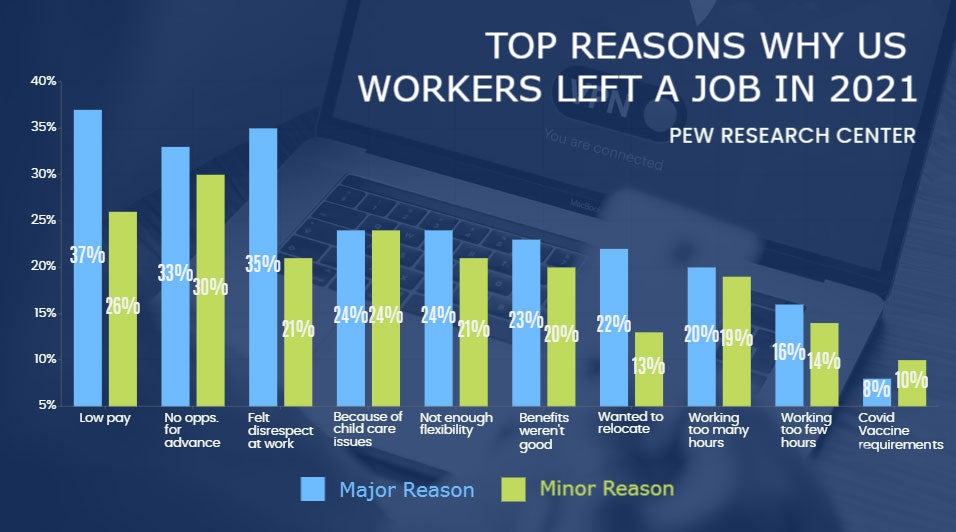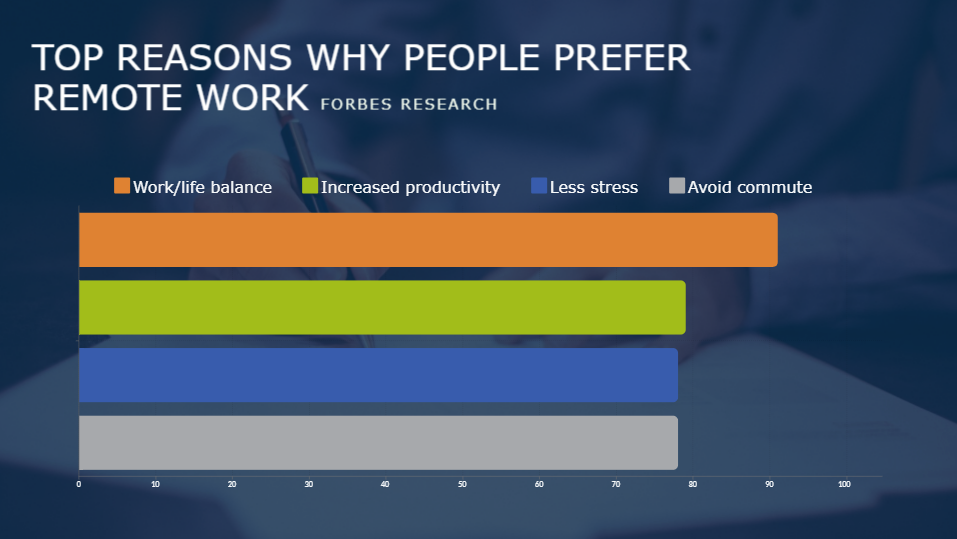June 30, 2022

The Great Resignation Key Takeaways:
- 11.5 Million vacant jobs in 2021, with 48% of people actively looking to switch jobs.
- The single biggest reason people cited for quitting was low pay, followed by feelings of disrespect and no advancement opportunities.
- Switching jobs during the pandemic led to a 10% or more pay increase for 49% of people.
- 91% of people feel they have a better work-life balance working from home.
- 52% of workers say they're feeling burned out.
- It's estimated the cost of replacing an employee is one half to twice the employee's salary.
- Companies scoring in the top 20% for their culture of recognition had turnover rates 31% lower.
From finance execs to delivery drivers, “The Great Resignation” are three words that seem to be on everyone’s lips. While some argue it’s a “reshuffle” rather than a “resignation,” there’s no debating that big change is happening to the American workforce.
What is The Great Resignation?
The phrase was coined by management professor, Anthony Klotz to describe the mass voluntary exit of workers from their jobs starting in early 2021. In fact, there were 11.5 million vacant jobs at the end of June 2021. And it's not over. Gallup research found that 48% of employees are actively looking to switch jobs, as well.
There's some debate regarding the origins of the Great Resignation. Was it caused by the Covid-19 Pandemic? Or did the pandemic merely exacerbate an already existing trend? Either way, this phenomenon has left HR departments everywhere reconsidering their retention strategies – that is, the companies who want to remain competitive are.
Why Did People Quit Their Jobs in 2021?
The entirety of this resignation is multifaceted, to say the least. But ultimately, there’s a discrepancy between what employees want (and now expect) from their jobs, and what companies are offering them.
According to research from Pew, the top reason people quit their job in 2021 was low pay. 37% of people cited low pay as a major factor, and 26% more saying it was a minor reason for quitting. 35% of people said feelings of disrespect was their main reason for quitting followed by 33% saying lack of advancement was their major reason for quitting.

So, if you've been wondering what you can do to stop the bleeding, you're not alone. Here's what we believe leaders should learn from the Great Resignation to retain employees today.
Values Have Shifted
Covid had a unique impact on everyone, but for many people, it reshaped priorities.
For the older generations, many experienced a bit of a "wake-up call." From missing milestones in their children’s lives. Or realizing the toll a stressful job is taking on their health isn’t worth the paycheck anymore. Covid was a harsh reminder that the 40+ hours we spend at work each week may not be time well spent.
Younger generations, however, aren't ready to sacrifice their well-being for a job from the get-go. When interviewed for a New York Times piece on this subject, 28 year-old Porsha Sharon said, "We’re like, ‘This job is overworking me, I’m getting sick because my body is shutting down, and I’m over it.' The last generation, they were miserable in their jobs but they stayed because that’s what they were supposed to do. We’re not like that, and I love that for us."
A pitfall to avoid here is thinking that people just don't want to work anymore. Many companies have adopted this mentality, and in doing so, have essentially surrendered. As former Secretary of Labor Robert Reich said, “No one wants to be exploited anymore.”
Furthering the sentiment, associate professor of labor studies at Rutgers, Rebecca Givan said, “Now workers are saying, ‘We’re going to hold our bosses accountable and demand more from them.’” While this has the potential to be intimidating, it also has the potential to evolve your company for the better.
Simply put: People don’t want to work for companies that don’t align with their values. So how do you know what your employees value? Ask them.
When was the last time you sat down and had a conversation with your employees about their priorities and goals, both professional and personal? And then what are you willing to do with that information to help align your employees' responsibilities with their values?
Show your team that you're willing to be an aid for them to achieve their goals. If you don't, employees will be open to opportunities that do align with their values.
Compensation Matters
The rules are changing when it comes to money etiquette. According to a survey from Bankrate, 42% of Gen Z workers and 40% of millennial workers have shared their salary information with coworkers. This means that younger employees are more likely to recognize a pay gap. And while some will stay to negotiate come review season, others will start job hunting now.

Job switching has shown to be an effective raise solution too. In fact, one survey found that 49% of people who switched jobs during the pandemic received a 10% or more pay increase. Furthermore, it found that 62% of people are concerned that their salary won't keep pace with inflation. Meaning, leaders should take the opportunity to prevent voluntary turnover by proactively addressing salary negotiations now. Waiting for employees to open the discussion just leaves the door open for them to take a better offer.
Speaking of inflation, it's common in today's market to see product costs increasing, yet salaries stay stagnant. If your company has raised its product prices but not its wages, know that your employees have noticed. And needless to say, they’re not happy about it. Ask yourself, were your cost-of-living raises at least 6% this year? Because if not, your employees essentially took a pay cut.
Be Flexible
“Business as usual” may be a thing of the past in many ways. One way is requiring 100% of workers to be in the office 100% of the time.
In a 2022 study from Pew, remote workers today feel more strongly than ever about making their arrangement permanent. 78% of people mostly working from home want to continue doing so after the pandemic, up from 64% in 2020.
Furthermore, a survey conducted by Upwork found that 61.9% of companies were planning for an increase in remote work now and in the following years. This same report predicted that nearly a quarter of Americans will be working remotely by the year 2025.
So what makes remote work so appealing? According to research by Forbes, 91% of people feel they have a better work-life balance. Followed by 79% being more productive, 78% are less stressed, and 78% enjoy avoiding a commute.
But it's not just employees who are pro-WFH, many companies are reaping the benefits too. Industry leaders such as Spotify, Lyft, and Twitter are among a wave of companies making the switch. High productivity and morale coupled with a decrease in overhead costs, like leases and utilities, these businesses are finding remote and hybrid models that are paving the way for others to follow.
Remote work does have some downsides, however. Pew research found that while people want to continue remote work, 60% of people feel less connected to their coworkers. Furthermore, there may be an increased risk of a more sedentary lifestyle without the need to walk to/around the office.
This is why many companies have found a sweet spot in hybrid work. Hybrid models bring the best of both worlds together, while minimizing both downsides. A report from Gallup recommends being home three to four days a week and in the office one to two days. Additionally, they recommend saving creative work for home and more tedious work for the office, where there's less temptation to procrastinate.
But essentially, working from home is here to stay. Finding the model that works for your company will be important for businesses to stay competitive. And effectively engaging remote employees will be critical for business success not only now, but in the future as well.

RELATED: Why Employee Recognition Software is Good for Your Business
And, if you're not offering hybrid, consider asking yourself why. How critical is it that the team be physically together all the time? How would offering your employees one or two remote days a week affect their wellbeing? What would their engagement be like now that they have a better work/life balance?
Research shows remote options are important to workers today, so if you don't offer it, you may be less appealing than a competitor to current and future hires.
Make Room for Mental Health
It’s safe to say the pandemic took a toll on our mental wellbeing. From isolation to anxiety to grief, it was a traumatic time for many people. And unfortunately, our mental health doesn’t always bounce back as quickly as we’d like.
In fact, in March of 2022, the WHO reported a 25% worldwide increase in anxiety and depression. Couple this with 52% of workers saying they're feeling burned out, and one thing's for sure: American workers are struggling.
So, what does this mean for team leaders? It’s a reminder that even though things are “getting back to normal,” your employees may not be feeling “normal.” Expecting the same level of output and performance may not be entirely fair.
Simply being aware of this shift can help you become a more compassionate leader, but there are other things you can do to help too. For example, tell your team that you know some may still be struggling and it’s ok. It will likely come as a relief to those who may have been suffering in silence for fear of backlash.
Additionally, pay attention. See if you notice employees regularly working through lunch or sending emails in the evening. And although some still believe remote employees don't work as hard, the data shows otherwise. 53% of remote workers say they work more hours now than they did in the office and 63% say they find it more difficult now to "unplug" after hours.
So, set an example. Company culture is determined from the top down. Be sure you have a healthy work/life balance and encourage others to do the same. Remind your employees to unplug at the end of the day and don't send emails after hours. Be careful about who you promote as well. If chronic over-workers are the ones who are "getting ahead," think about the message that sends to other employees.

Also encourage employees to use their PTO - and consider offering more of it. According to Indeed, 36% of all workers say more PTO could help reduce their burnout. Two weeks may be standard, but what if you offered three? What if every month had at least one three-day weekend? What about giving more PTO around the holidays?
Remember though, time off isn't the cure to burnout, it's an additional support. Organization psychologist Adam Grant says, "The holidays shouldn’t be a time to recharge. They should be a time to celebrate. If work is exhausting people to the point that they’re using their time off to recover, you might have a burnout culture. A healthy organization doesn’t leave people drained in the first place."
Furthermore, consider allowing mental health days, starting a wellness program, and offering free counseling through an Employee Assistance Program. Talking about how you care about mental wellness is good, but implementing processes to help support mental wellness is what matters most.
Create a Recognition Culture
While we've discussed value and priority shifts, mental wellness, and flexibility, ultimately if your employees don't feel like their role matters, it will be difficult to retain them. One way to show your employees that they matter is with employee recognition.
Effective employee recognition is linked to increased employee retention, morale, and job engagement. So, if you don’t have a recognition program set up, now is the time to seriously consider it.
Research from Forbes has found that companies scoring in the top 20% for their culture of recognition had turnover rates 31% lower. However, according to a Gallup poll, only one in three employees were recognized for their work in the last 7 days. Another report found that employees had averaged 50 days since they were last recognized. This means, although recognition programs work, they're not being used enough.
With packed calendars and long to-do lists, managers oftentimes feel like they don't have the time to give meaningful recognition to their employees. They see the work their team does and value it, but fall short in taking the time to acknowledge it in an impactful way. Time passes, the moment is lost, and employees feel undervalued.
This is seen in companies everywhere. And while it may be common, it's simply not good business.
Gallup estimates the cost of replacing an employee is one half to twice the employee's salary. Meaning, a 100-person organization that pays an average salary of $50k could experience turnover costs from $660,000 to $2.6 million a year. Not to mention the cost it can have on company morale.
To help reduce turnover, try an online employee recognition software, like Terryberry's recognition platform. This allows recognition to happen in real time through a social feed, and empowers employees by supporting peer-to-peer recognition. Infuse purpose back into employees’ work by acknowledging their efforts and showing them how they’re a part of a bigger mission.
Living in unprecedented times calls for leaders to rethink the status quo. Without making conscious efforts to adapt to the changing times, you’re risking your employees leaving you behind. But leaders who are willing to offer flexibility and compassion, along with a fair wage will likely be the companies who come out on top.
Interested in learning more about how your company can benefit from a recognition program? Schedule a demo of Terryberry's recognition platform today.
